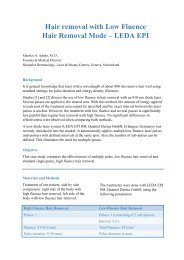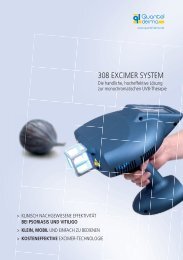Hair removal with LEDA EPI 980 - Quantel Derma
Hair removal with LEDA EPI 980 - Quantel Derma
Hair removal with LEDA EPI 980 - Quantel Derma
You also want an ePaper? Increase the reach of your titles
YUMPU automatically turns print PDFs into web optimized ePapers that Google loves.
<strong>Hair</strong> <strong>removal</strong> <strong>with</strong> <strong>LEDA</strong> <strong>EPI</strong> <strong>980</strong> -<br />
Decisive wavelength for hair <strong>removal</strong> for Indian skin types<br />
Dr B. S. Chandrashekar<br />
Chief <strong>Derma</strong>tologist CUTIS - Academy of Cutaneous Sciences, Bangalore, India<br />
Background<br />
Hirsutism is a common problem for which laser is the treatment of choice. The use of lasers for hair <strong>removal</strong> has<br />
been studied for a number of years. In this procedure, laser light is absorbed by melanin in the hair shaft, damaging<br />
the follicular epithelium. Several lasers <strong>with</strong> different wavelengths, pulse durations, energy densities and<br />
skin cooling systems, are currently used for hair <strong>removal</strong>. However, the ideal wavelength for darker skin types is<br />
not yet found in regards to efficacy and safety for the patients.<br />
Objective<br />
A clinical study to evaluate the <strong>LEDA</strong> <strong>EPI</strong> <strong>980</strong> (<strong>Quantel</strong> <strong>Derma</strong>, Erlangen, Germany), a Diode Laser <strong>with</strong> a<br />
wavelength of <strong>980</strong> nm for hair <strong>removal</strong> was conducted at Cutis. The wavelength used by <strong>LEDA</strong> <strong>EPI</strong> <strong>980</strong> is<br />
supposed to be effective and safe for hair <strong>removal</strong> in darker skin types. It is close to the wavelength of 1,064<br />
nm - the currently preferred wavelength for darker skin types - but far less painful and at the same time safer<br />
than 808 nm.<br />
Materials and Methods<br />
100 female patients of different hair and skin types in the age group of 18 to 56 years were tested for the tolerability<br />
and efficacy of <strong>LEDA</strong> <strong>EPI</strong> <strong>980</strong>. All patients were treated for 6 sessions <strong>with</strong> <strong>LEDA</strong> <strong>EPI</strong> <strong>980</strong> <strong>with</strong> contact<br />
cooling.<br />
We used the treatment parameters of 18 - 35 ms pulse duration and a fluence of 24 - 40 J/cm 2 , depending on<br />
skin type and hair color.<br />
Pre and post treatment pictures were taken at each session of hair <strong>removal</strong>.<br />
Five patients underwent a split face study to compare <strong>LEDA</strong> <strong>EPI</strong> 808 (<strong>Quantel</strong> <strong>Derma</strong>) <strong>with</strong> 808 nm wavelength<br />
and <strong>LEDA</strong> <strong>EPI</strong> <strong>980</strong> <strong>with</strong> <strong>980</strong> nm wavelength. Efficacy, tolerability and adverse events were recorded both by<br />
patients and physicians.<br />
Clinical Images<br />
Split face study <strong>LEDA</strong> <strong>EPI</strong> 808 / <strong>980</strong><br />
The images compare the efficacy of<br />
<strong>LEDA</strong> <strong>EPI</strong> 808 and <strong>LEDA</strong> <strong>EPI</strong> <strong>980</strong> on<br />
darker sin (skin type 3).<br />
The pictures where taken before the<br />
first treatment and after the 6 th treatment<br />
session.<br />
The pictures clearly show that <strong>LEDA</strong><br />
<strong>EPI</strong> <strong>980</strong> is more effective on Indian<br />
skin than <strong>LEDA</strong> <strong>EPI</strong> 808.<br />
Chin - right side<br />
Before treatment<br />
<strong>LEDA</strong> <strong>EPI</strong> 808<br />
Chin - left side<br />
Before treatment<br />
<strong>LEDA</strong> <strong>EPI</strong> <strong>980</strong><br />
3 months after 6 th session<br />
3 months after 6 th session
Clinical Images <strong>LEDA</strong> <strong>EPI</strong> <strong>980</strong><br />
The images show the effectiveness of hair <strong>removal</strong> <strong>with</strong> <strong>LEDA</strong> <strong>EPI</strong> <strong>980</strong>. The number of hair is visibly reduced.<br />
Left axilla<br />
Right axilla<br />
Chin<br />
Before treatment<br />
Before treatment<br />
Before treatment<br />
Before treatment<br />
3 months after 6 th session<br />
3 months after 6 th session 3 months after 6 th session<br />
Courtesy of Dr. Jagadish Sakiya<br />
3 months after 6 th session<br />
Results<br />
After 6 sessions, all patients showed a decisive hair reduction of 60 - 80% depending on the hair color and type.<br />
The split face study comparing <strong>LEDA</strong> <strong>EPI</strong> 808 and <strong>LEDA</strong> <strong>EPI</strong> <strong>980</strong> clearly showed that <strong>LEDA</strong> <strong>EPI</strong> <strong>980</strong> is more<br />
effective, safer and faster than <strong>LEDA</strong> <strong>EPI</strong> 808 on Indian skin.<br />
Regrowing hairs were shown to be thinner and lighter. Patient selection, proper use of the<br />
laser and appropriate parameter settings have shown to cause permanent hair reduction <strong>with</strong>out damaging the<br />
epidermis even at high fluences, regardless of skin and hair type.<br />
Conclusion<br />
Extensive clinical use of this highpower, multi faceted, <strong>980</strong> nm diode laser system has shown clear benefits<br />
over standard 808 nm hair <strong>removal</strong>, probably signalling the arrival of a decisive wavelength for hair <strong>removal</strong><br />
amongst patients <strong>with</strong> darker skin types such as Indian skin.<br />
Note: This case study is part of an ongoing study.<br />
Literature<br />
[1] Rao K, Sankar TK. Long-pulsed Nd:YAG laser-assisted hair <strong>removal</strong> in Fitzpatrick skin types IV-VI. Lasers Med Sci. 2011 Apr.<br />
[2] Braun M. Permanent Laser <strong>Hair</strong> Removal With Low Fluence High Repetition Rate Versus High Fluence Low Repetition Rate 810 nm Diode<br />
Laser – A Split Leg Comparison Study. J Drugs Derm. 2009 Nov; 8 (11): 14 -17.<br />
[3] Hammes S, Ockenfels HM, Metelmann H-R, Raulin C, Karsai S. Ein neuer Ansatz in der Laser-Haarreduktion – Diodenlaser mit SHR<br />
(„Super <strong>Hair</strong> Removal“) im Vergleich mit dem Alexandritlaser. Hautarzt 2010; 61: 880-884.<br />
<strong>Quantel</strong> <strong>Derma</strong> GmbH<br />
Am Wolfsmantel 46<br />
91058 Erlangen, Germany<br />
info@quantel-derma.com<br />
www.leda-system.com<br />
March 2012






